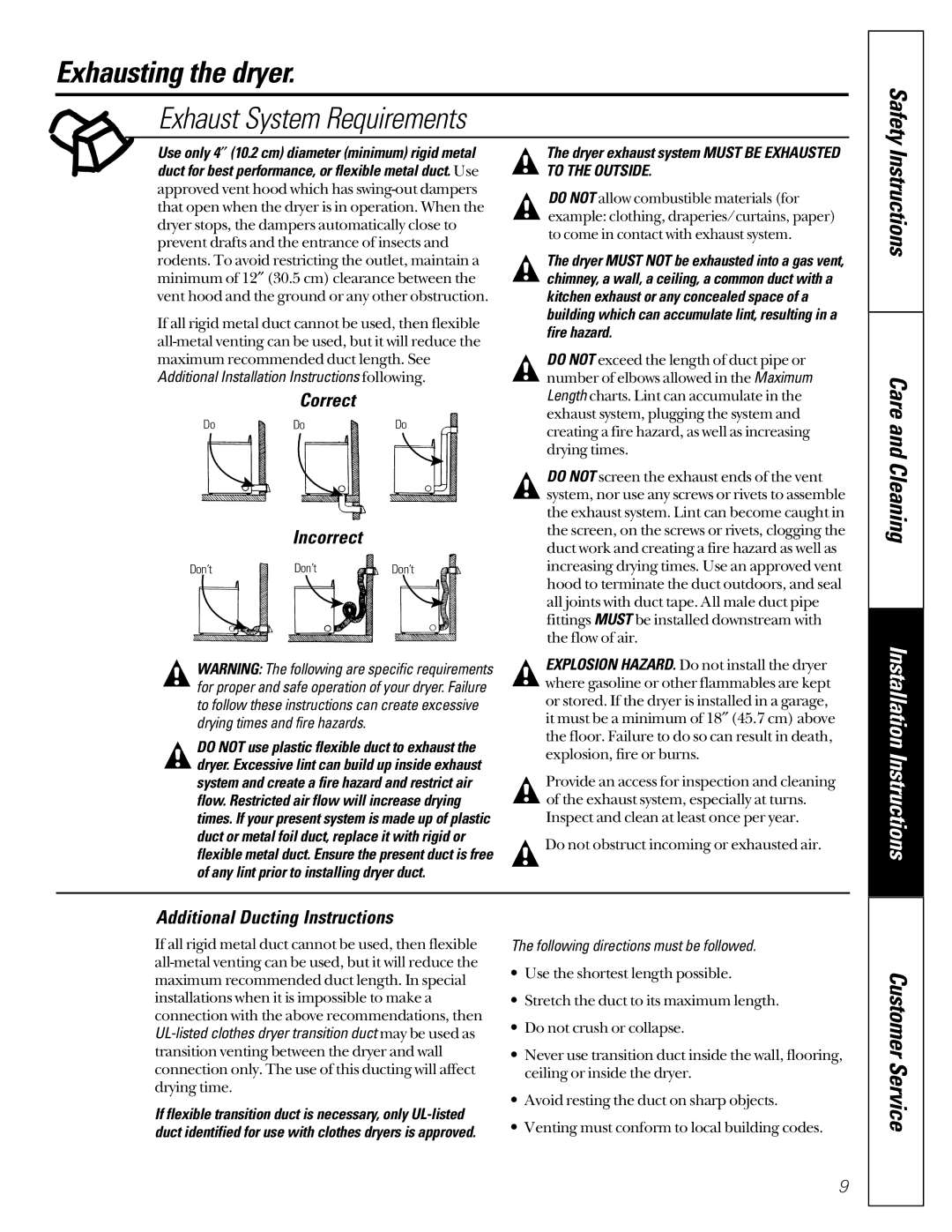
Exhausting the dryer.
Exhaust System Requirements
Safety
Use only 4″ (10.2 cm) diameter (minimum) rigid metal duct for best performance, or flexible metal duct. Use approved vent hood which has
If all rigid metal duct cannot be used, then flexible
Correct
Do | Do | Do |
Incorrect
Don’t | Don’t | Don’t |
The dryer exhaust system MUST BE EXHAUSTED TO THE OUTSIDE.
DO NOT allow combustible materials (for example: clothing, draperies/curtains, paper) to come in contact with exhaust system.
The dryer MUST NOT be exhausted into a gas vent, chimney, a wall, a ceiling, a common duct with a kitchen exhaust or any concealed space of a building which can accumulate lint, resulting in a fire hazard.
DO NOT exceed the length of duct pipe or number of elbows allowed in the Maximum Length charts. Lint can accumulate in the exhaust system, plugging the system and creating a fire hazard, as well as increasing drying times.
DO NOT screen the exhaust ends of the vent system, nor use any screws or rivets to assemble the exhaust system. Lint can become caught in the screen, on the screws or rivets, clogging the duct work and creating a fire hazard as well as increasing drying times. Use an approved vent hood to terminate the duct outdoors, and seal all joints with duct tape. All male duct pipe fittings MUST be installed downstream with the flow of air.
Instructions
Care and Cleaning
WARNING: The following are specific requirements for proper and safe operation of your dryer. Failure to follow these instructions can create excessive drying times and fire hazards.
DO NOT use plastic flexible duct to exhaust the dryer. Excessive lint can build up inside exhaust system and create a fire hazard and restrict air flow. Restricted air flow will increase drying times. If your present system is made up of plastic duct or metal foil duct, replace it with rigid or flexible metal duct. Ensure the present duct is free of any lint prior to installing dryer duct.
EXPLOSION HAZARD. Do not install the dryer where gasoline or other flammables are kept or stored. If the dryer is installed in a garage, it must be a minimum of 18″ (45.7 cm) above the floor. Failure to do so can result in death, explosion, fire or burns.
Provide an access for inspection and cleaning of the exhaust system, especially at turns. Inspect and clean at least once per year.
![]() Do not obstruct incoming or exhausted air.
Do not obstruct incoming or exhausted air.
Installation Instructions
Additional Ducting Instructions
If all rigid metal duct cannot be used, then flexible
If flexible transition duct is necessary, only
The following directions must be followed.
•Use the shortest length possible.
•Stretch the duct to its maximum length.
•Do not crush or collapse.
•Never use transition duct inside the wall, flooring, ceiling or inside the dryer.
•Avoid resting the duct on sharp objects.
•Venting must conform to local building codes.
Customer Service
9
